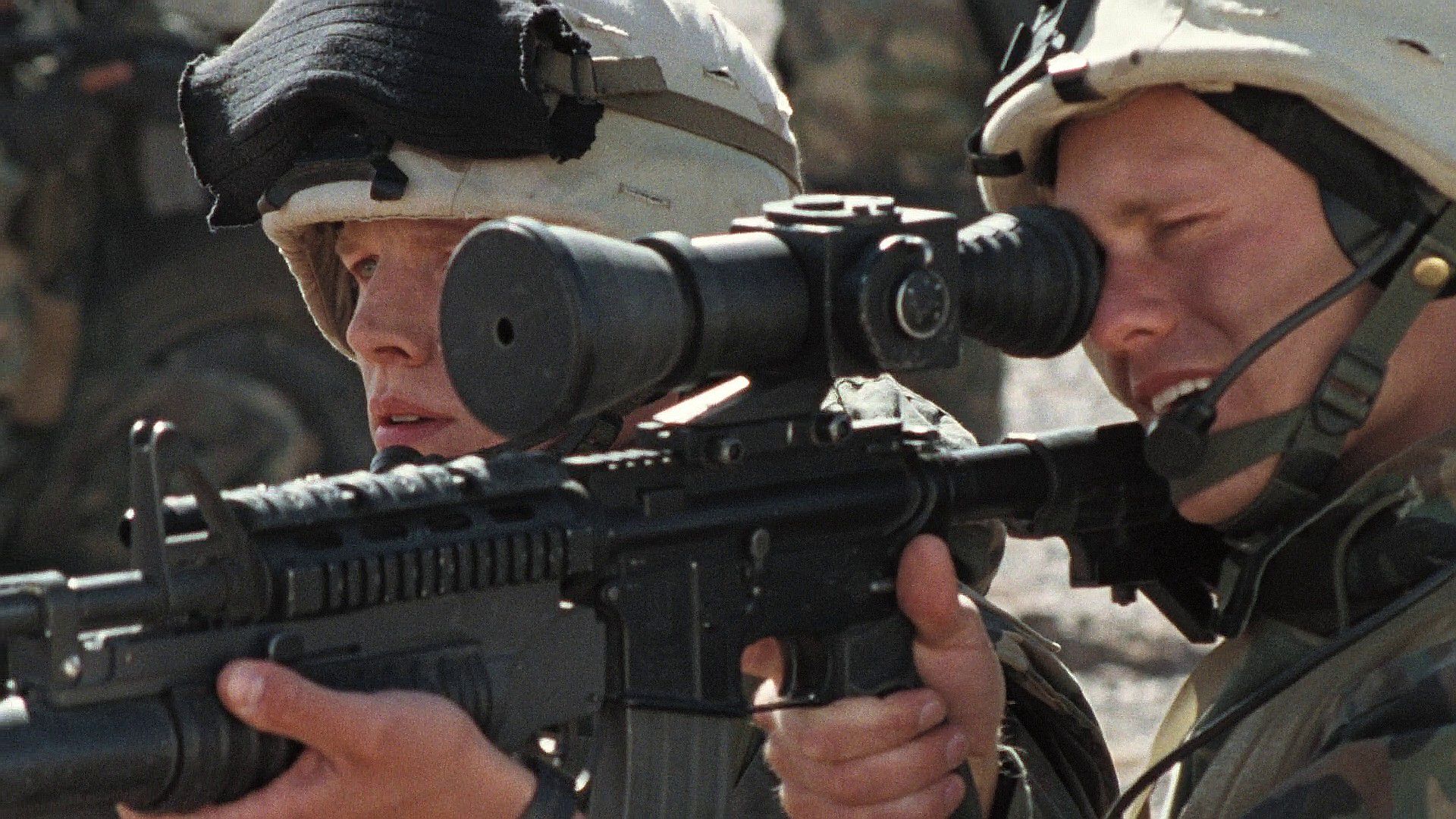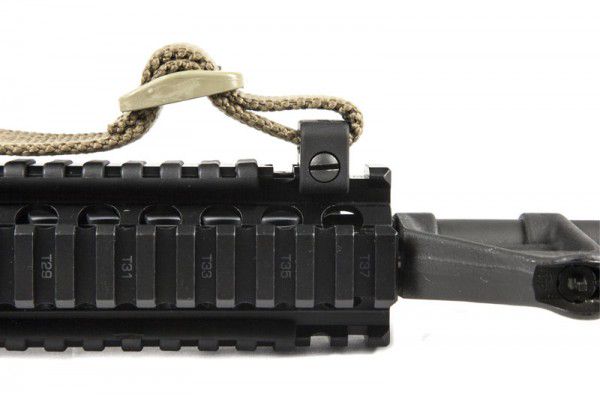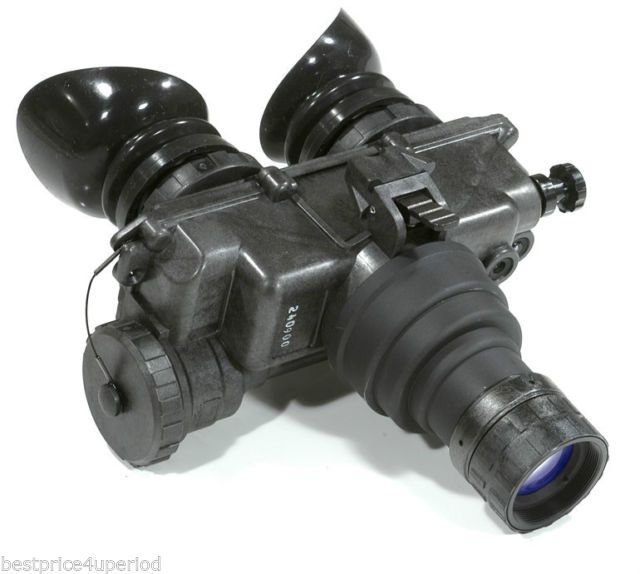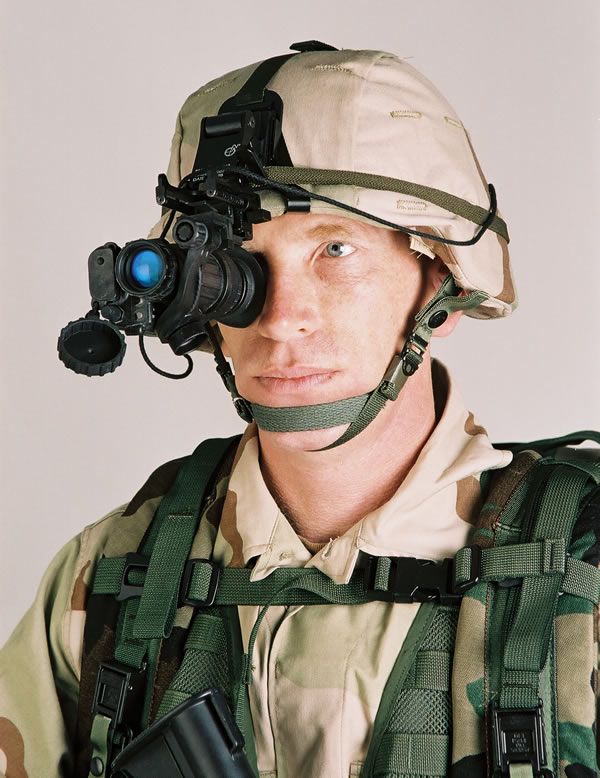NIGHT VISION/RIFLE OPTICS/RAILS
In this chapter, I will outline the basic use and type of Night Vision Devices (NVD)used in today's Corps. The USMC uses a variety of Night Optic Devices (NOD) as well as Rifle Scopes. From Infra Red scopes to Thermal Imaging, these devices are used by infantrymen as well as armor and aircraft.
Night Vision Device (NVD) is being used by Rifleman, Armor, and Aircraft with great effect.
Night Optic Device (NOD) refers to a scope or Infra Red Thermal Targeting system mounted on a rifle or gun.
Night Vision Goggles (NVG's) are referred to optics worn on the head and helmet to give full visibility at night.
Thermal Weapon Sight (TWS) are Scopes and Night Vision which reads biological heat signatures.
***************ROE***************
RIFLE OPTICS/NOD
RCO 4X32 - Is the basic USMC Rifle Combat Optic, identifiable by the Red Chevron. The Army version is called an ACOG (Advanced CombatOptical Gunsight.) This Optic IS NOT NIGHT OPTIC.


4x32
FIRST NUMBER - 4 (x), is the magnification x four, i.e. targets viewed are 4x greater in size. SECOND NUMBER - (x) 32, is the diameter of the end part of the scope. The larger the diameter, the clearer and brighter the magnification. However, with larger diameter scopes, more battery power is necessary.
AN/PAS-13B (called 13 Bravos)


Employment - A Thermal Weapon Sight (TWS) with IR (infrared). It is designed for use on rifles as well as a standalone observation device. Because of its TWS, it can be used day or night, and through smoke/fog.
In Service - 1998 - Present
PEQ 15 (BOX) - Portillons d'Extrémité de Quai (The translation makes no sense)


Employment - Projects a visible/IR red dot. The IR (infrared illuminator/target designator) is only seen with NVD's. The visible dot is not visible to the naked eye. The unit comprises a single rugged box that mounts onto a Picatinny rail. It can be mounted on the top of the rifle or side pending the rail system in use. (see below photo for placement of PEQ 15)


MODES - The following is a chart for the different modes of the PEQ15. Likewise, the device has a pressure switch. (below grid)


TRACER ROUNDS - I decided to put this here instead of Ammo section, as it is primarily an illumination round, not penetrative round. It is different from.an incendiary round.


Employment - projectiles that are built with a small pyrotechnic charge in their base. The illumination can be seen during the day and mostly at night. It provides better targeting when firing upon an enemy. There are three types of tracers: the bright tracer, subdued tracer, and dim tracer. Dim tracers burn very dimly but are clearly visible through night-vision equipment.
They can come with a Red, Blue, or Orange tip. They are usually placed every fifth round. They also have an incendiary quality, penetrating and burning the target inside of the entrance wound.
PIC RAIL (Picatinny Rail)


Employment - Used for attachments of externals, NVD's, M203's, and Optics. Below is a picture of my M4.
(the picture will be up soon. I have to find it.)
***************ROE***************
STAND ALONE SPOTTING SCOPES
M49


Employment - A Multipurpose Observation Scope system used primarily for long-range observation. While it is mostly a fixed NVD, it can be handheld. The M49 does not have an adjustable sunshade; however, the front end of the body tube extends approximately three-quarters of an inch beyond the objective providing a permanent sunshade.
Date of Service - WWII - Present
MK4 (Sniper Spotting Optic)


Employment - The Standard Scout Sniper Observation Telescope (SSOT) of the U.S. Marine Corps. This replaced the M49 spotting scope fielded by the Marines since World War II. It is used solely by USMC Sniper Spotters.
***************ROE***************
Night Vision Goggles (NVG)
AN/PVS-7 (Army Navy Portable Vision System)


Employment - The goggles have active night vision using a built-in infrared LED for low light situations. They are waterproof and charged with nitrogen to prevent internal condensation while moving between extreme temperatures. They are on their Fourth Generation. See diagram below to view generation clarity.
In Service - 1985 - Present
AN/PVS 14 (what I used)


(I love this picture because this marine is wearing the DCU's - Desert Camoflauge Uniform, with LBV - Load Bearing Vest. This is what I wore in the corps, althought we did have plate carriers as well.)
Employment - It uses a third generation tube and is hands-free. It uses a head harness or attached to a combat helmet (Kevlar) such as a PASGT Personnel Armor System for Ground Troops (seen in above picture.) It can also be used as a weapons night sight. The Rifleman would place the monocular on his Non-Firing Eye.
In Service - 2000 - Present
***************ROE***************
Speaking The Language
******EXAM TIME******
For this chapter, I thought it best for you to Watch/Observe/Listen to the video at the top of the page (banner). See if you can identify the NVD's, and terminology we have talked about so far.
If you have any questions, please feel free to ask inline.

Bạn đang đọc truyện trên: AzTruyen.Top